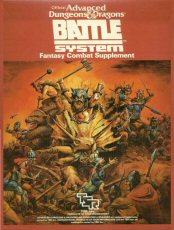Battlesystem
Battlesystem is a tabletop miniature wargame designed as a supplement for use with the Dungeons & Dragons role-playing game. It was first published in 1985 and was usable with either Advanced Dungeons & Dragons or the Basic/Expert/etc Dungeons & Dragons (see editions of Dungeons & Dragons). The game was promoted as a successor to Chainmail and thus as a return to the wargame roots of Dungeons & Dragons.[1]
In a Battlesystem game each miniature represents multiple troops (10, 5, or 2, depending on the troops' level or hit dice) or a single hero or commander.[2] There are no statistics in the game for any troops or characters, instead all are derived from the relevant Dungeons & Dragons publications. This means that any creature from the Monster Manual or similar publications can be used as 'troops', with their in-game point cost based on the XP reward listed for killing the creature.[3]
First edition

The first edition of Battlesystem was sold as a box set which contained:[4]
- 32-page rule book
- 24-page scenario book
- 16-page guide to miniatures
- 2 Player Aid Cards
- 2 Metal Miniature Generals
- 3-D Adventure foldup Figures
- Army Roster Sheets
- 801 die-cut counters
The Rulebook is divided into four parts that allow three levels of play. Part 1 is an introduction. Part 2, The Basic Game, covers the basic rules of movement and melee combat.[5] Part 3, The Intermediate Game, adds missiles, artillery, cavalry, individual Heroes, special formations and terrain effects.[6] Part 4, The Advanced Game allows for Magic, flying, weather, night battles and special monsters as well as introducing campaign rules that allow for integration of Battlesystem games into a role-playing campaign.[7] The game can be played either with or without a Dungeon Master, though use of a referee is strongly recommended if using certain magics such as invisibility or illusions.[8]
The Scenario Book contains 4 scenarios. Three of the scenarios form a linked campaign in a generic Fantasy setting, one for each level of the game. The fourth is an Advanced Game scenario for Dragonlance, Battle of Qualinost, that takes place during the time period of DL2 Dragons of Flame while the heroes are in Pax Tharkas.[9]
The game rules state that it was designed to be played with either 25 mm or 15 mm miniatures. However although the game did not require a certain size of miniatures, the official Battlesystem miniatures that were released at the time, except for the two in the box set that were 25 mm, were all in 15 mm scale. Also at the time many companies producing 25 mm figures were starting to make larger figures, sometimes even officially called as 'Heroic 25 mm' or 28 mm, that were hard to fit on the official Battlesystem base sizes.
Second Edition
The second edition of Battlesystem, for use with 2nd Edition Advanced Dungeons & Dragons, was available in the form of two books Battlesystem (1989) and Battlesystem Skirmishes (1991)
One significant change was the move to assumption of using 25 mm miniatures as standard. 15 mm could still be used according to the rules, but the base size was increased to allow for larger 25 mm miniatures and all photographs in the rule book were of 25 mm miniatures.
The game won the 1989 Origins Award for "Best Miniatures Rules of 1989".[10]
Notes
- ^ "With the BATTLESYSTEM game, the AD&D and D&D games go back to their roots" (Niles 1985a:1)
- ^ (Niles 1985a:2)
- ^ (Niles 1985a:31)
- ^ As listed on box and in Game Parts section (Niles 1985a:1)
- ^ (Niles 1985a:8)
- ^ (Niles 1985a:16)
- ^ (Niles 1985a:20)
- ^ (Niles 1985a:1)
- ^ (Niles 1985b)
- ^ "1989 List of Winners". Academy of Adventure Gaming, Arts & Design. Retrieved 2007-03-17.
{{cite web}}: Cite has empty unknown parameter:|coauthors=(help)
References
- Dobson, Michael (1985). "From first draft to last gasp". Dragon #100. X (3). TSR: 96–98. ISSN 0279-6848.
{{cite journal}}: Cite has empty unknown parameter:|coauthors=(help); Unknown parameter|month=ignored (help) - Musson, Roger (1985). "Notices: Battlesystem". Imagine (30). TSR UK: 43.
{{cite journal}}: Cite has empty unknown parameter:|coauthors=(help); Unknown parameter|month=ignored (help) - Niles, Douglas (1985a). Battlesystem Rulebook. TSR.
{{cite book}}: Cite has empty unknown parameter:|coauthors=(help) from Battlesystem: Fantasy Combat Supplement Boxed set. - Niles, Douglas (1985b). Battlesystem Scenario Book. TSR.
{{cite book}}: Cite has empty unknown parameter:|coauthors=(help) from Battlesystem: Fantasy Combat Supplement Boxed set. - Niles, Doug (1985). "The chance of a lifetime". Dragon #100. X (3). TSR: 86–94. ISSN 0279-6848.
{{cite journal}}: Cite has empty unknown parameter:|coauthors=(help); Unknown parameter|month=ignored (help) - Niles, Douglas (1989). Battlesystem. TSR. ISBN 0-88038-770-X.
{{cite book}}: Cite has empty unknown parameter:|coauthors=(help) - Nesmith, Bruce (1991). Battlesystem Skirmishes. TSR. ISBN 1-56076-141-5.
{{cite book}}: Cite has empty unknown parameter:|coauthors=(help) - Winter, Steven (1985). The Art of Three-Dimensional Gaming. TSR.
{{cite book}}: Cite has empty unknown parameter:|coauthors=(help) from Battlesystem: Fantasy Combat Supplement Boxed set. - "Battlesystem". The Miniatures Page. 1999-09-04. Retrieved 2007-03-17.
{{cite web}}: Cite has empty unknown parameter:|coauthors=(help)
Additional reading
- "Sage Advice", Dragon #132.
Reviews:
- Dragon #178 (1992)
- The V.I.P. of Gaming Magazine #2 (1986)
- The V.I.P. of Gaming Magazine #3 (1986)
